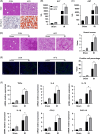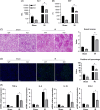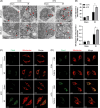ER stress promotes mitochondrial calcium overload and activates the ROS/NLRP3 axis to mediate fatty liver ischemic injury
- PMID: 38497930
- PMCID: PMC10948136
- DOI: 10.1097/HC9.0000000000000399
ER stress promotes mitochondrial calcium overload and activates the ROS/NLRP3 axis to mediate fatty liver ischemic injury
Abstract
Background: Fatty livers are widely accepted as marginal donors for liver transplantation but are more susceptible to liver ischemia and reperfusion (IR) injury. Increased macrophage-related inflammation plays an important role in the aggravation of fatty liver IR injury. Here, we investigate the precise mechanism by which endoplasmic reticulum (ER) stress activates macrophage NOD-like receptor thermal protein domain-associated protein 3 (NLRP3) signaling by regulating mitochondrial calcium overload in fatty liver IR.
Methods: Control- and high-fat diet-fed mice were subjected to a partial liver IR model. The ER stress, mitochondrial calcium levels, and NLRP3 signaling pathway in macrophages were analyzed.
Results: Liver steatosis exacerbated liver inflammation and IR injury and enhanced NLRP3 activation in macrophages. Myeloid NLRP3 deficiency attenuated intrahepatic inflammation and fatty liver injury following IR. Mechanistically, increased ER stress and mitochondrial calcium overload were observed in macrophages obtained from mouse fatty livers after IR. Suppression of ER stress by tauroursodeoxycholic acid effectively downregulated mitochondrial calcium accumulation and suppressed NLRP3 activation in macrophages, leading to decreased inflammatory IR injury in fatty livers. Moreover, Xestospongin-C-mediated inhibition of mitochondrial calcium influx decreased reactive oxygen species (ROS) expression in macrophages after IR. Scavenging of mitochondrial ROS by mito-TEMPO suppressed macrophage NLRP3 activation and IR injury in fatty livers, indicating that excessive mitochondrial ROS production was responsible for macrophage NLRP3 activation induced by mitochondrial calcium overload. Patients with fatty liver also exhibited upregulated activation of NLRP3 and the ER stress signaling pathway after IR.
Conclusions: Our findings suggest that ER stress promotes mitochondrial calcium overload to activate ROS/NLRP3 signaling pathways within macrophages during IR-stimulated inflammatory responses associated with fatty livers.
Copyright © 2024 The Author(s). Published by Wolters Kluwer Health, Inc. on behalf of the American Association for the Study of Liver Diseases.
Conflict of interest statement
The authors have no conflicts to report.
Figures








Similar articles
-
TARGETING S100A9-TLR2 AXIS CONTROLS MACROPHAGE NLRP3 INFLAMMASOME ACTIVATION IN FATTY LIVER ISCHEMIA REPERFUSION INJURY.Shock. 2025 Feb 1;63(2):292-298. doi: 10.1097/SHK.0000000000002470. Epub 2024 Oct 21. Shock. 2025. PMID: 39447083 Free PMC article.
-
Aging aggravated liver ischemia and reperfusion injury by promoting STING-mediated NLRP3 activation in macrophages.Aging Cell. 2020 Aug;19(8):e13186. doi: 10.1111/acel.13186. Epub 2020 Jul 14. Aging Cell. 2020. PMID: 32666684 Free PMC article.
-
Jagged1-mediated myeloid Notch1 signaling activates HSF1/Snail and controls NLRP3 inflammasome activation in liver inflammatory injury.Cell Mol Immunol. 2020 Dec;17(12):1245-1256. doi: 10.1038/s41423-019-0318-x. Epub 2019 Oct 31. Cell Mol Immunol. 2020. PMID: 31673056 Free PMC article.
-
The Role of Endoplasmic Reticulum Stress and NLRP3 Inflammasome in Liver Disorders.Int J Mol Sci. 2022 Mar 24;23(7):3528. doi: 10.3390/ijms23073528. Int J Mol Sci. 2022. PMID: 35408890 Free PMC article. Review.
-
Reactive Oxygen Species Induce Fatty Liver and Ischemia-Reperfusion Injury by Promoting Inflammation and Cell Death.Front Immunol. 2022 Apr 29;13:870239. doi: 10.3389/fimmu.2022.870239. eCollection 2022. Front Immunol. 2022. PMID: 35572532 Free PMC article. Review.
Cited by
-
Breaking the Feedback Loop of β-Cell Failure: Insight into the Pancreatic β-Cell's ER-Mitochondria Redox Balance.Cells. 2025 Mar 8;14(6):399. doi: 10.3390/cells14060399. Cells. 2025. PMID: 40136648 Free PMC article. Review.
-
Protein modifications in hepatic ischemia-reperfusion injury: molecular mechanisms and targeted therapy.Front Immunol. 2025 Apr 11;16:1553298. doi: 10.3389/fimmu.2025.1553298. eCollection 2025. Front Immunol. 2025. PMID: 40292278 Free PMC article. Review.
-
Unraveling the Mystery of Insulin Resistance: From Principle Mechanistic Insights and Consequences to Therapeutic Interventions.Int J Mol Sci. 2025 Mar 19;26(6):2770. doi: 10.3390/ijms26062770. Int J Mol Sci. 2025. PMID: 40141412 Free PMC article. Review.
-
Metal ions overloading and cell death.Cell Biol Toxicol. 2024 Aug 20;40(1):72. doi: 10.1007/s10565-024-09910-4. Cell Biol Toxicol. 2024. PMID: 39162885 Free PMC article. Review.
-
Prognostic value of ALBI score for all-cause mortality in metabolic associated fatty liver disease patients: a cohort study from NHANES 2003-2018.BMC Gastroenterol. 2025 Aug 7;25(1):561. doi: 10.1186/s12876-025-04117-1. BMC Gastroenterol. 2025. PMID: 40775283 Free PMC article.
References
-
- Cotter TG, Rinella M. Nonalcoholic fatty liver disease 2020: The state of the disease. Gastroenterology. 2020;158:1851–1864. - PubMed
-
- Gedallovich SM, Ladner DP, VanWagner LB. Liver transplantation in the era of non-alcoholic fatty liver disease/metabolic (dysfunction) associated fatty liver disease: The dilemma of the steatotic liver graft on transplantation and recipient survival. Hepatobiliary Surg Nutr. 2022;11:425–429. - PMC - PubMed
-
- Varela AT, Rolo AP, Palmeira CM. Fatty liver and ischemia/reperfusion: Are there drugs able to mitigate injury? Curr Med Chem. 2011;18:4987–5002. - PubMed
Publication types
MeSH terms
Substances
LinkOut - more resources
Full Text Sources

